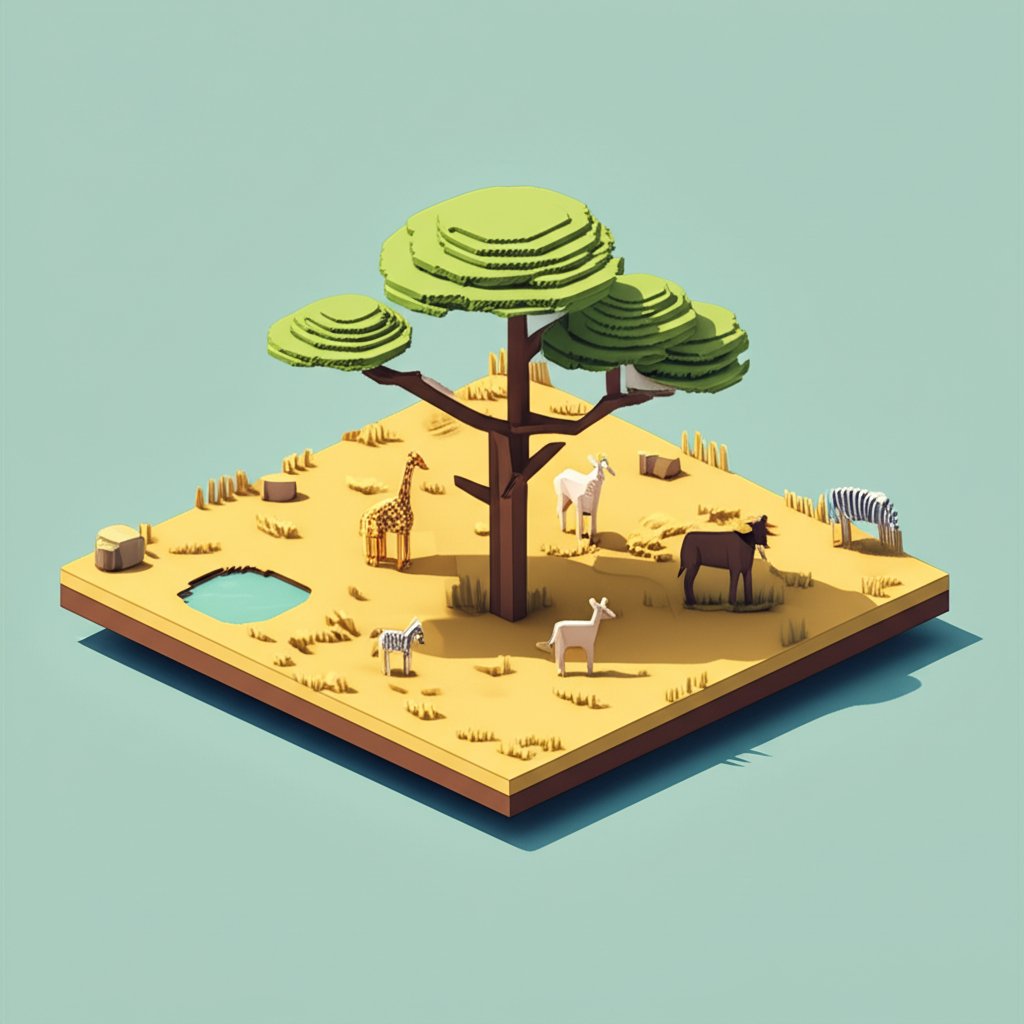The savanna biome. Mention the name, and images of vast African plains, iconic acacia trees, and thundering herds immediately spring to mind. But beneath this breathtaking surface lies a world of intricate secrets and astonishing adaptations. Far more than just grasslands with scattered trees, savannas are dynamic, resilient ecosystems that have captivated scientists and explorers for centuries.
Are you ready to delve into a realm where fires rejuvenate, elephants garden, and life dances to the dramatic rhythm of wet and dry seasons? Get ready to uncover 10 mind-blowing savanna biome facts and secrets that will forever change how you view these magnificent landscapes. We’ll explore the characteristics of savanna biome that make it so unique, reveal facts about savanna biome found across continents, and share some truly savanna biome fun facts that highlight its incredible biodiversity and ecological importance. Prepare to be amazed by the raw power and subtle beauty that define this global powerhouse.
The Global Stage: Where Savannas Reign Supreme
One of the most profound savanna biome interesting facts is its global reach and incredible diversity, often much greater than commonly perceived.
A World of Diverse Savannas: Beyond the African Icon
While the African savanna, epitomized by the Serengeti and Maasai Mara, is undeniably the most famous, these unique biomes are a global tapestry spanning across continents. South America boasts its own vast savannas, like the Brazilian Cerrado (one of the most biodiverse savannas on Earth) and the Venezuelan Llanos, teeming with distinct flora and fauna. Australia’s northern territories feature extensive tropical savannas, while parts of India and Southeast Asia also host smaller, yet significant, savanna ecosystems.
Far from being uniform, savannas exhibit fascinating regional variations. Ecologists categorize them into different types:
This global distribution highlights that the defining characteristics of savanna biome are not tied to a single geography but rather a specific set of climatic and ecological forces.
Defining Characteristics of the Savanna Biome: A Unique Blend
What exactly defines a savanna? It’s a biome characterized by a harmonious fusion of trees and grasslands, forming a continuous grass layer with scattered, isolated woody plants. Crucially, the tree canopy does not close, allowing ample sunlight to reach the ground. The annual rainfall ranges significantly, typically between 500 mm (20 inches) and 1,270 mm (50 inches) per year, with the majority falling during a distinct wet season, followed by a period of drought. This seasonal water availability is a key differentiating factor.
Fact 1: The Global Chameleon – Savannas Are Far More Widespread and Varied Than Just African Plains.
They are found in tropical, subtropical, and even some temperate regions, each with unique plant and animal species adapted to local conditions, often exhibiting characteristics of both forests and deserts.
Climate’s Dramatic Dance: Life Shaped by Extremes
The savanna biome facts rooted in its climate reveal a world of dramatic seasonal shifts that dictate the very pulse of life.
The Rhythms of Wet and Dry Seasons
The savanna’s heartbeat follows a distinct rhythm, driven by the sun’s position and the movement of the Intertropical Convergence Zone (ITCZ). During the wet season, which can last from six to eight months, the landscape transforms into a lush, vibrant oasis. Heavy, convective rainfall nourishes the grasses and trees, and waterholes fill, providing abundant resources for wildlife. This is a time of plenty, when food is abundant and animals thrive and reproduce.
As the sun shifts, the ITCZ follows, bringing the dry season. This period, often characterized by intense heat and little to no rain, unveils a more austere beauty. Grasses turn golden and brittle, water sources shrink, and the scorching sun bakes the earth. This dramatic contrast forces incredible adaptations among its inhabitants.
Plant Adaptations: Surviving the Sun and Scarcity
Savanna plants are masters of survival. Grasses, the dominant vegetation, are typically fast-growing and drought-resistant, with deep roots to tap into groundwater. Many perennial grasses die back to their roots during the dry season, conserving energy and quickly regrowing when the rains return. Trees like acacias and baobabs often have small, waxy leaves or shed their leaves during the dry season to minimize water loss. Some, like the iconic Baobab, store vast amounts of water in their trunks.
Fact 2: Climate’s Dramatic Duet – The Savanna’s Life-and-Death Cycle is Orchestrated by Extreme Wet and Dry Seasons.
These distinct periods, driven by global weather patterns, force plants into dormancy and trigger epic animal migrations, making seasonal adaptation the ultimate survival skill.
Fire, the Primal Sculptor: Renewal and Resilience
Perhaps one of the most counterintuitive yet crucial facts about savanna biome is the essential role fire plays in its very existence.
The Essential Role of Wildfires
Fire, both natural (from lightning strikes) and human-induced, is not merely a destructive force in the savanna; it’s an integral part of its life cycle and a vital rejuvenator. Fires typically occur during the dry season, clearing old, dead grass and woody growth. This prevents the encroachment of dense forests and allows sunlight to reach the ground, stimulating the growth of fresh, nutrient-rich grasses when the rains return. Without fire, many savannas would eventually transition into woodlands or forests, losing their unique characteristics.
Fire-Adapted Flora and Fauna
Many savanna plants have evolved remarkable adaptations to survive and even thrive in the face of fire. Some grasses have underground growing points, allowing them to resprout quickly after a fire. Many tree species possess thick, fire-resistant bark, while others have seeds that require the heat or smoke from fires to germinate. Animals, too, are adapted; many large mammals can outrun fires, while smaller creatures burrow into the ground. The new growth that follows a fire provides a crucial food source, attracting grazers.
Fact 3: Fire’s Fiery Embrace – Savannas Don’t Just Survive Fires; They Need Them to Thrive.
Fires are a critical natural process that prevents forest encroachment, clears old vegetation, and stimulates new growth, with many plants possessing incredible fire-resistant adaptations.
Architectural Wonders: The Open Canopy & Ecological Balance

The characteristics of savanna biome are perhaps most visually striking in its unique open canopy structure, which is far more than just sparse trees.
Why Trees Stand Apart: A Strategic Design
Picture a vast, sunlit landscape adorned with isolated trees standing tall like guardians, casting dappled shadows on the vibrant grass below. Unlike dense forests where trees form an interlocking embrace, savannas boast an open, spacious canopy. Trees are generously spaced, their branches reaching skyward without hindrance. This unique structure is a symphony of nature’s design, orchestrated by factors like fire frequency, grazing pressure, and soil moisture levels, which collectively limit woody plant density.
Sunlight, Grasses, and Grazers: An Interconnected System
The open canopy plays a crucial role in the savanna’s ecology. Direct sunlight can penetrate to the ground, fostering a diverse array of grasses, shrubs, and wildflowers. This vibrant understory forms the foundation of the savanna food web, feeding and sheltering a wide range of creatures. Equally important, the open canopy allows animals to roam freely. Grazing herbivores, such as zebras and wildebeest, have ample space to migrate and search for food without dense vegetation impeding their movement or vision. Predators like lions and leopards can easily navigate the terrain, using scattered trees as strategic vantage points for hunting or shade.
Fact 4: The Open-Air Architect – The Savanna’s Scattered Tree Canopy Isn’t Random; It’s a Delicately Balanced, Fire- and Grazer-Maintained Architectural Marvel.
This “light-filled” design ensures maximum sunlight for essential grasses, facilitates the movement of vast herds, and supports an intricate web of life unlike any other biome.
The Grand Herds & Mighty Hunters: A Symphony of Life
No discussion of savanna biome fun facts would be complete without highlighting its spectacular wildlife, from the iconic grazers to the formidable predators.
Herbivore Superpowers: Ecosystem Engineers and Migratory Feats
The savanna is a herbivore paradise, home to some of the world’s largest land mammals. Wide-eyed zebras, graceful giraffes, powerful buffalo, and colossal elephants roam these plains, each playing a crucial role in maintaining the ecosystem’s delicate balance. This diverse herbivore population contributes to the savanna by:
The most mind-blowing aspect? The Great Migration of wildebeest, zebras, and gazelles in East Africa – an annual, circular journey of millions of animals covering thousands of kilometers in search of greener pastures. This epic movement is a testament to the power of seasonal rhythms and a critical mechanism for the savanna’s health, distributing nutrients and allowing grazed areas to recover.
Fact 5: The Earth’s Largest Lunchroom – Herbivores Are Not Just Eaters; They Are the Savanna’s Ecosystem Engineers.
From niche-partitioned grazing that maintains plant diversity to epic migrations that reshape landscapes, these animals are crucial for the biome’s structure and nutrient cycling.
Apex Predators: Masters of the Hunt
Where there are abundant herbivores, there are formidable predators. The savanna is the stage for epic predator-prey battles, showcasing incredible adaptations for survival. Lions, leopards, cheetahs, and hyenas represent the apex hunters, each with specialized skills:
These predators help regulate herbivore populations, ensuring the health and vigor of the herds. Their presence is a vital sign of a balanced savanna biome.
Fact 6: Predators’ Paradise – Savanna Predators Are Master Strategists, Whose Survival is Intricately Linked to Herbivore Migrations and Ecological Balance.
Their diverse hunting techniques and social structures are finely tuned adaptations to the savanna’s open landscape and seasonal challenges, preventing overgrazing and maintaining healthy ecosystems.
Micro-Secrets & Macro-Impacts: Hidden Wonders
Beyond the grand spectacles, the savanna holds smaller, yet equally fascinating, savanna biome interesting facts and secrets that underpin its resilience.
Lifelines in the Dry: Dambos and Ephemeral Water Sources
Nestled within the savanna’s vast expanse are pockets of lush greenery and temporary wetlands known as “dambos” (especially in central and southern Africa). These low-lying, seasonally flooded grasslands serve as critical sanctuaries during the dry season, providing life-giving refuge, water, and forage for wildlife amidst the surrounding aridity. Similarly, many rivers in the savanna are ephemeral, flowing only during the wet season, leaving behind a network of dry riverbeds that animals instinctively know to follow to find residual moisture or permanent waterholes. These hidden oases are vital to the survival of countless species.
The Baobab Tree: A Living Legend and Lifesaver
The African Baobab (Adansonia digitata) is a tree unlike any other, and its presence is one of the most iconic characteristics of savanna biome. Often called the “Tree of Life” or “upside-down tree,” it’s a true natural marvel.
Fact 7: Hidden Waterworlds – Dambos and Ephemeral Rivers Are the Savanna’s Secret Lifelines, Crucially Sustaining Life Through the Arid Dry Season.
These temporary oases are hotspots of biodiversity and critical refugia for animals when other water sources vanish.
Fact 8: The Baobab’s Resilience – This Iconic “Upside-Down Tree” Is a Living Water Tower and Ecosystem Hub, Capable of Storing Thousands of Liters of Water.
Its colossal trunk and extreme longevity make it a symbol of savanna adaptation and a crucial resource for countless species.
Our Deep Roots: Savannas as the Cradle of Humanity

Perhaps the most profound of all facts about savanna biome is its indelible link to human existence.
Hominids’ Haven: Why Savannas Fostered Human Evolution
The savanna has played a profound and pivotal role in the story of humankind. It was in the savannas of East Africa that early hominids thrived, embarking on the evolutionary journey that led to modern humans. The open landscape offered crucial advantages:
Archaeological treasures unearthed in these grasslands continue to shed light on our origins, making the savanna not just an ecosystem, but our ancestral home.
Fact 9: A Cradle of Humanity – The Savanna Biome Wasn’t Just Where Humans Appeared; It Actively Shaped Our Evolution.
The open landscape, diverse resources, and environmental challenges directly fostered bipedalism, tool use, and cognitive development in early hominids.
The Future of the Wild Heart: Challenges and Conservation
As we explore these savanna biome facts, it’s crucial to acknowledge the challenges this vital biome faces and its inherent resilience.
Threats to a Vital Biome
Despite their robustness, savannas are under increasing pressure from human activities.
The Untamed Resilience: Hope for Tomorrow
However, the very characteristics of savanna biome – its adaptations to fire, drought, and intense grazing – also speak to its remarkable resilience. Effective conservation strategies, community involvement, anti-poaching efforts, and sustainable land management are crucial to protect these irreplaceable ecosystems. By understanding the intricate facts about savanna biome, we can better appreciate its value and work towards its preservation.
Fact 10: Under Threat, Yet Resilient – Despite Facing Severe Pressures from Climate Change and Human Encroachment, Savannas Possess an Extraordinary Intrinsic Resilience.
Their deep-rooted grasses, fire-adapted trees, and migratory animals are built to withstand extreme shifts, offering hope for conservation through informed management.
Conclusion
The savanna biome is an extraordinary testament to nature’s ingenuity – a landscape of dramatic contrasts, intricate adaptations, and breathtaking life. From the sweeping movements of its great herds to the silent resilience of its ancient trees, every aspect reveals a deeper secret about survival and balance. We’ve journeyed through the characteristics of savanna biome, unveiled compelling savanna biome facts, and illuminated savanna biome fun facts that paint a picture of an ecosystem that is both ancient and ever-changing.
Understanding these mind-blowing savanna biome facts is more than just learning about nature; it’s about appreciating the delicate interdependencies that allow life to thrive in challenging environments. The savanna reminds us of the planet’s incredible biodiversity and the urgent need to protect these wild hearts of our world for future generations.
FAQ
Q1: How widespread are savannas globally?
A1: Savannas are broadly distributed across tropical, subtropical, and even some temperate regions worldwide. They are most extensive in Africa, home to iconic savannas like the Serengeti, but also found in large areas of South America (e.g., the Cerrado, Llanos), northern Australia, and parts of India and Southeast Asia.
Q2: What is the defining characteristic of the savanna’s canopy structure?
A2: The defining characteristic is an open canopy structure. Unlike forests, trees in savannas are widely spaced and do not form a continuous, interlocking canopy. This allows ample sunlight to reach the ground, supporting a diverse and continuous layer of grasses, which is a key characteristic of savanna biome.
Q3: Why are savannas described as “transitional biomes”?
A3: Savannas are considered transitional biomes because they share characteristics of both forests (having trees) and grasslands (dominated by grasses). They typically occur in regions with too much rain for a desert but not enough to support a dense forest, featuring distinct wet and dry seasons that create this unique blend of ecological traits.
Q4: What factors drive the contrasting wet and dry seasons in savannas?
A4: The contrasting wet and dry seasons are primarily driven by the seasonal movement of the Intertropical Convergence Zone (ITCZ). When the ITCZ is overhead, it brings warm, moist air and heavy rainfall (wet season). As the ITCZ moves away, the region experiences stable, dry conditions (dry season), which is a crucial savanna biome fact.
Q5: How do herbivores contribute to the dynamics of savanna ecosystems?
A5: Herbivores are essential ecosystem engineers in savannas. Through grazing and browsing, they control the growth of grasses and woody vegetation, preventing forests from encroaching. Their migrations distribute nutrients, and their hooves aerate the soil. This complex interplay between vegetation, herbivores, and fires maintains the savanna’s unique characteristics and biodiversity.
Q6: What role does fire play in the savanna biome?
A6: Fire is a natural and critical component of the savanna biome. It clears old, dead vegetation, prevents the growth of dense woody plants, and stimulates fresh grass growth when the rains return. Many savanna plants are fire-adapted, highlighting this essential savanna biome interesting fact.
Q7: What are some unique plant adaptations found in savannas?
A7: Savanna plants have evolved remarkable adaptations to survive seasonal droughts and fires. These include deep root systems to access groundwater, shedding leaves during dry seasons, thick fire-resistant bark, and water storage in trunks (e.g., the Baobab tree). Grasses often have underground growing points, allowing rapid regrowth after fire or grazing.










